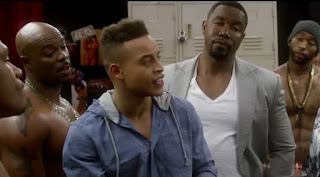Movie Review - Finding Dory
Ostensibly, this is the sequel to Finding Nemo (2003), one of the best films to come out the Pixar animation studio. Pixar has made several sequels to its successful originals. Of those sequels, the ones that soared were the continuations of its Toy Story franchise. In many ways, the Toy Story franchise has established what Pixar's brand is and what the themes and elements of every movie will be. This film certainly fits in that brand and doesn't deviate. However, this film doesn't surpass the Toy Story sequels because it doesn't have the emotional weight of something like Toy Story 3. Even though the characters change and grow, Toy Story 3 feels like it had way more progression, whereas this feels like there's way more regression.
Like Monsters University, this movie is more of a prequel. Even though the majority of the action takes place after Finding Nemo, instead of moving forward, this film is moving backward. It's essentially the origin story for Dory, the blue tang fish, voiced by Ellen DeGeneres. Because of her disability of suffering from short-term memory loss, she never was able to tell from where she came. This movie rectifies by taking us all the way back to her birth place, and to her parents on the opposite side of the Pacific Ocean. Finding Nemo was set at the Great Barrier Reef.
Yet, this film is not about Dory connecting to her parents. The search for them is merely the premise. Her connection to them is simply superfluous, or it's a device for self-improvement or self-motivation. Her parents are basically the McGuffin. The only true familial connection is the one between the parent-child who were the subject of the previous film. The clownfish named Marlin, voiced by Albert Brooks, and his son, Nemo, voiced by Hayden Rolence, spent the last film mostly separated. This time, the two are really able to be together and bond. It's all in service of reaffirming Marlin's relationship with Dory and his need to be more trusting of her and others, but still.
A refrain in this movie is "What would Dory do." All the characters have to learn to trust her or embrace her way of being. This doesn't just include fish, but an octopus with a lost limb named Hank, voiced by Ed O'Neill, as well as a couple of larger creatures, including a near-sighted, whale-shark named Destiny, voiced by Kaitlin Olson, and a beluga whale with broken echo-location named Bailey, voiced by Ty Burrell. Like Dory, each of these other aquatic animals has a disability and each has to overcome the fears of failure that are attached to that disability.
Given this film arrives in the wake of such documentaries as Blackfish and news events that question having animals in captivity, one way to read this movie is for its pro-environmentalism, or the idea in general that all aquatic animals don't want any interactions with humans or shouldn't be within the confines of human structures. This film isn't as anti-human as the previous feature, but it could support that interpretation.
Director Andrew Stanton with Angus MacLane, despite targeting children, repeats the Pixar tendency to depict children as scary monsters. In fact, there is a scene here that echoes a sequence in Toy Story 3 where the characters in question are seemingly attacked by wild children who have no regard for the feelings or the welfare of the things that are vulnerable. Beyond that, humans are not the bad guys here. Humans are helpful as another refrain is "Rescue, Rehabilitation, Release," a refrain by one human in particular, famously known for her pro-environmentalism movies a la Avatar and Gorillas in the Mist.
Even though the filmmakers don't hit the audience over the head with it, there are subtle touches that show the pollution and the waste that's being dropped in the Pacific. At one point, Dory gets caught in a plastic, six-pack ring. The end credits also include some shots of Hank and others swimming through the human junk that's been sunk and abandoned on the ocean floor.
The jokes are well-done. The vocal performances are winsome and distinctive. It's not as glorious to watch because a lot of the movie takes place in the human world without saying too much about it, as opposed to Finding Nemo, which really embraced all the wonders of the Pacific Ocean. The previous feature also felt informative but in a very subtle way. Teaching moments come through a bit more clunky here. The short-term memory loss also comes through as more a plot-device than an actual affliction. The film is entertaining, but lacks the emotional punch that even Pixar's last Oscar-winner, Inside Out, had.
Four Stars out of Five.
Rated PG for mild thematic elements.
Running Time: 1 hr. and 43 mins.
Like Monsters University, this movie is more of a prequel. Even though the majority of the action takes place after Finding Nemo, instead of moving forward, this film is moving backward. It's essentially the origin story for Dory, the blue tang fish, voiced by Ellen DeGeneres. Because of her disability of suffering from short-term memory loss, she never was able to tell from where she came. This movie rectifies by taking us all the way back to her birth place, and to her parents on the opposite side of the Pacific Ocean. Finding Nemo was set at the Great Barrier Reef.
Yet, this film is not about Dory connecting to her parents. The search for them is merely the premise. Her connection to them is simply superfluous, or it's a device for self-improvement or self-motivation. Her parents are basically the McGuffin. The only true familial connection is the one between the parent-child who were the subject of the previous film. The clownfish named Marlin, voiced by Albert Brooks, and his son, Nemo, voiced by Hayden Rolence, spent the last film mostly separated. This time, the two are really able to be together and bond. It's all in service of reaffirming Marlin's relationship with Dory and his need to be more trusting of her and others, but still.
A refrain in this movie is "What would Dory do." All the characters have to learn to trust her or embrace her way of being. This doesn't just include fish, but an octopus with a lost limb named Hank, voiced by Ed O'Neill, as well as a couple of larger creatures, including a near-sighted, whale-shark named Destiny, voiced by Kaitlin Olson, and a beluga whale with broken echo-location named Bailey, voiced by Ty Burrell. Like Dory, each of these other aquatic animals has a disability and each has to overcome the fears of failure that are attached to that disability.
Given this film arrives in the wake of such documentaries as Blackfish and news events that question having animals in captivity, one way to read this movie is for its pro-environmentalism, or the idea in general that all aquatic animals don't want any interactions with humans or shouldn't be within the confines of human structures. This film isn't as anti-human as the previous feature, but it could support that interpretation.
Director Andrew Stanton with Angus MacLane, despite targeting children, repeats the Pixar tendency to depict children as scary monsters. In fact, there is a scene here that echoes a sequence in Toy Story 3 where the characters in question are seemingly attacked by wild children who have no regard for the feelings or the welfare of the things that are vulnerable. Beyond that, humans are not the bad guys here. Humans are helpful as another refrain is "Rescue, Rehabilitation, Release," a refrain by one human in particular, famously known for her pro-environmentalism movies a la Avatar and Gorillas in the Mist.
Even though the filmmakers don't hit the audience over the head with it, there are subtle touches that show the pollution and the waste that's being dropped in the Pacific. At one point, Dory gets caught in a plastic, six-pack ring. The end credits also include some shots of Hank and others swimming through the human junk that's been sunk and abandoned on the ocean floor.
The jokes are well-done. The vocal performances are winsome and distinctive. It's not as glorious to watch because a lot of the movie takes place in the human world without saying too much about it, as opposed to Finding Nemo, which really embraced all the wonders of the Pacific Ocean. The previous feature also felt informative but in a very subtle way. Teaching moments come through a bit more clunky here. The short-term memory loss also comes through as more a plot-device than an actual affliction. The film is entertaining, but lacks the emotional punch that even Pixar's last Oscar-winner, Inside Out, had.
Four Stars out of Five.
Rated PG for mild thematic elements.
Running Time: 1 hr. and 43 mins.











Comments
Post a Comment